Family name: Asteraceae Berchtold & J. Presl or Compositae Giseke
Synonym(s): Acarnaceae Link, nom. illeg.; Ambrosiaceae Bercht. & J. Presl, nom. cons.; Anthemidaceae Bercht. & J. Presl; Aposeridaceae Raf.; Arctotidaceae Bercht. & J. Presl; Artemisiaceae Martinov; Athanasiaceae Martinov; Calendulaceae Bercht. & J. Presl; Carduaceae Bercht. & J. Presl; Cassiniaceae Sch. Bip., nom. inval.; Cichoriaceae Juss., nom. cons.; Compositae Giseke, nom. cons.; Coreopsidaceae Link, nom. inval.; Cynaraceae Spenn.; Echinopaceae Bercht. & J. Presl; Eupatoriaceae Bercht. & J. Presl; Helichrysaceae Link, nom. inval.; Inulaceae Bercht. & J. Presl; Lactucaceae Drude; Mutisiaceae Burnett; Partheniaceae Link, nom. inval.; Perdiciaceae Link, nom. inval.; Senecionaceae Bercht. & J. Presl; Vernoniaceae Burmeist.
Common name(s): aster family
*Number of genera/species: 1,683/24,700
List of genera records in GRIN-Global
Fruit a cypselacypsela:
dry, indehiscent, unilocular fruit with a single seed not adnate to the pericarp, similar to an achene but developed from an inferior ovary. Fruit type of Asteraceae.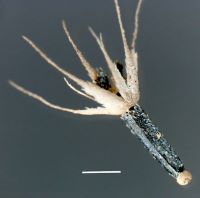 , rarely drupe (Chrysanthemoides, Wulffia), aggregated in a head (head rarely dispersal unit). Fruits within the head sometimes heteromorphic for various traits. Fruits usually 2–5 mm long but range from 0.2–70 mm long (including beaks, if present), globoseglobose:
, rarely drupe (Chrysanthemoides, Wulffia), aggregated in a head (head rarely dispersal unit). Fruits within the head sometimes heteromorphic for various traits. Fruits usually 2–5 mm long but range from 0.2–70 mm long (including beaks, if present), globoseglobose:
3D shape—more or less spherical to angledangular:
to angledangular:
2D shape—having sides that meet at acute or obtuse angles
, sometimes curvedcurved:
(of embryo) linear embryo is curved into an arch or horseshoe with the ends far apart , contorted, or coiledcoiled:
, contorted, or coiledcoiled:
(of embryo) linear embryo is very long and bent to form a coil whereby one end of the embryo is on the outside and the other end near the middle of the seed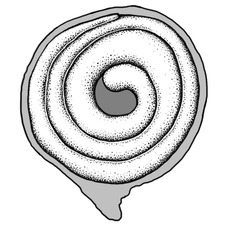 , tereteterete:
, tereteterete:
approximately circular in cross section; width and thickness approximately equal
 , compressedcompressed:
, compressedcompressed:
flattened; in grasses, used to denote compression (not necessarily flattened) either laterally or dorsiventrally
, or flattened in transection, usually with distinctive apicalapical:
at or pertaining to the end of the seed or fruit distal from its point of attachment (i.e., base)
rims or crowns, which may be smooth, dentatedentate:
regularly spaced, teeth oriented more or less perpendicular to the central axis bearing them , or crenulatecrenulate:
, or crenulatecrenulate:
finely crenate (scalloped)
, around persistent stylestyle:
in a flower, the narrow and elongated part of the pistil between the stigma and the ovary; sometimes persisting in fruit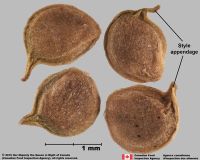 bases. Fruits sometimes beakedbeak:
bases. Fruits sometimes beakedbeak:
a usually firm, terminal appendage, sometimes tapered , if beakedbeak:
, if beakedbeak:
a usually firm, terminal appendage, sometimes tapered then often attenuate, winged or not. If winged, 1–3(–20) wings, wings laterallateral:
then often attenuate, winged or not. If winged, 1–3(–20) wings, wings laterallateral:
(of embryo) embryo lies along the side of the seed, generally towards one end; of, at, or from the side; in grasses, can refer to the sides adjacent to the dorsal and ventral sides
or encompassing fruit, paperypapery:
texture—papyraceous, chartaceous; very thin, pliable, and readily torn; like paper
, membranousmembranous:
texture—extremely thin, pliable, and fairly tough
, or corkycorky:
firm, relatively light, discontinuous but strongly cohesive, and resilient
.
CypselaeCypsela:
dry, indehiscent, unilocular fruit with a single seed not adnate to the pericarp, similar to an achene but developed from an inferior ovary. Fruit type of Asteraceae. with one seed, usually crowned by bristles, scales, or awnsawn:
with one seed, usually crowned by bristles, scales, or awnsawn:
a narrow, bristle-like organ, as on the glumes or lemmas of grasses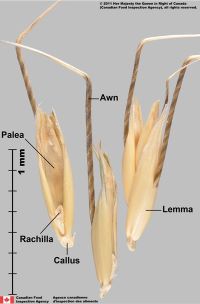 (=highly modified calyces called a pappi), pappi sometimes deciduousdeciduous:
(=highly modified calyces called a pappi), pappi sometimes deciduousdeciduous:
falling off; not persistent
(falling as a unit) or absent. CypselaeCypsela:
dry, indehiscent, unilocular fruit with a single seed not adnate to the pericarp, similar to an achene but developed from an inferior ovary. Fruit type of Asteraceae. rarely enclosed by persistent phyllaries or receptacular bracts, if present often hardened and forming burs (e.g. Acanthospermum, Ambrosia, Xanthium). Pappi usually white, yellow, or brown, sometimes purple, orange, or red, uniseriateuniseriate:
rarely enclosed by persistent phyllaries or receptacular bracts, if present often hardened and forming burs (e.g. Acanthospermum, Ambrosia, Xanthium). Pappi usually white, yellow, or brown, sometimes purple, orange, or red, uniseriateuniseriate:
arranged in a single row; e.g. seeds arranged in a single row within a locule
or biseriatebiseriate:
arranged in two rows; e.g. seeds arranged in two rows within a locule
, and more than one form may be present on fruit. Abscission scars (or hilahilum:
on seeds, the scar indicating where the funiculus was attached; on grass caryopses, the scar visible on the outer fruit surface revealing where the seed is attached on the inner fruit wall surface; or in Asteraceae cypselae, the scar visible on the outer fruit wall revealing where the fruit was attached to the receptacle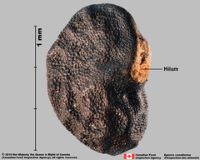 ) basalbasal:
) basalbasal:
at or pertaining to the point of attachment; (of embryo) embryo occupies one end of the seed
, laterallateral:
(of embryo) embryo lies along the side of the seed, generally towards one end; of, at, or from the side; in grasses, can refer to the sides adjacent to the dorsal and ventral sides
, or caudatecaudate:
tapering to a long, tail-like appendage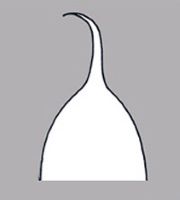 , circularcircular:
, circularcircular:
(of embryo) linear embryo is curved into an "O" shape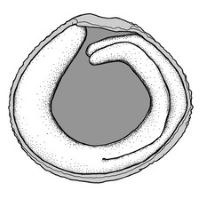 , usually surrounded by distinct tissue, called carpopodiumcarpopodium:
, usually surrounded by distinct tissue, called carpopodiumcarpopodium:
an elongation of the base of the gynoecium which looks distinct, as in the cypselae of some Asteraceae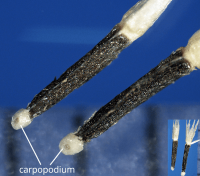 . Carpopodia form narrow to tubular rings around abscission scars, up to 1/3 the length of the fruit body, differing in texture from scars and fruit surface, or are absent.
. Carpopodia form narrow to tubular rings around abscission scars, up to 1/3 the length of the fruit body, differing in texture from scars and fruit surface, or are absent.
Pericarp usually black or brown, sometimes pale blue, green, gray, red, yellow, or white, streaked or mottledmottled:
with colored spots, streaks, or blotches of a different color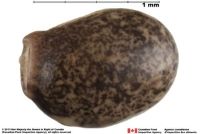 , rarely blue-black (drupelike fruits, Chrysanthemoides), often phytomelan present contributing to black or darkly streaked color (Asteroideae, Heliantheae alliance), shinyshiny:
, rarely blue-black (drupelike fruits, Chrysanthemoides), often phytomelan present contributing to black or darkly streaked color (Asteroideae, Heliantheae alliance), shinyshiny:
uniformly reflecting a high proportion of incident light at all angles or dulldull:
or dulldull:
reflecting only a low proportion of incident light, with no apparent sheen , often hardened, smooth or ribbedribbed:
, often hardened, smooth or ribbedribbed:
surface relief—wide, prominent, linear ridges that are generally rounded and longitudinally situated on the surface (3–40 ribs), ridgedridged:
(3–40 ribs), ridgedridged:
surface relief—raised, thick ridges, sharp edged or rounded, usually in a series that may cover the entire surface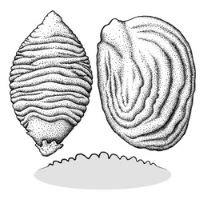 , groovedgrooved:
, groovedgrooved:
surface relief—linear depressions that may be single or form a series of grooves over the surface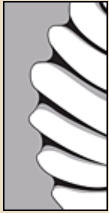 (rarely), pittedpitted:
(rarely), pittedpitted:
surface relief—surface with small depressions in which the areas between the hollows do not take on the appearance of a true reticular net , reticulatereticulate:
, reticulatereticulate:
surface relief—netted, raised walls or concave grooves forming a net-like surface pattern with flat, concave, or convex interspaces , wartywarty:
, wartywarty:
surface relief—distinct, rounded projections that are large relative to the fruit size; tuberculate, verrucose , wrinkledwrinkled:
, wrinkledwrinkled:
surface relief—shallow, irregular folds and furrows covering the surface; appearing overall though crumpled and then spread out , papillosepapillate:
, papillosepapillate:
surface relief—bearing minute, distinct, broad-based projections, tapering to a rounded apex , spiculiferous (bearing spicules or needle-like protrusion), muricatemuricate:
, spiculiferous (bearing spicules or needle-like protrusion), muricatemuricate:
surface relief—rough with small, hard, sharp projections
, scalyscaly:
surface relief—covered with small, thin, fine scales or flakes that may be removable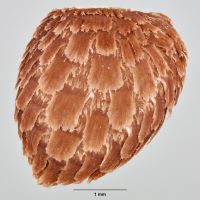 , veinedveined:
, veinedveined:
surface relief—lines that intersect in a vein pattern that is flush or slightly raised from the surface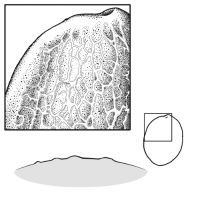 , or with hookswith hooks:
, or with hookswith hooks:
bristles or spines with curved or backwards pointing tips, or with secondary bristles along their length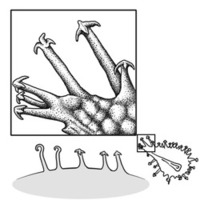 , bristles, spines, myxogenicmyxogenic:
, bristles, spines, myxogenicmyxogenic:
mucilaginous when wetted
cells, resin sacs or canals, and/or gland-dotted.
Fruits glabrousglabrous:
without hairs
or pubescentpubescent:
surface relief—bearing hairs
, if pubescentpubescent:
surface relief—bearing hairs
, sparsely to densely so, with various types of hairs present, which may aid in identification (uniseriateuniseriate:
arranged in a single row; e.g. seeds arranged in a single row within a locule
barnadesioid, multicellular, one-celled, glandularglandular:
surface relief—covered with small, raised secretory glands, regular or irregularly shaped, translucent or opaque, and maybe distinctly colored , twin, rarely glochidiform). Pubescence or surface relief features may be restricted to apicalapical:
, twin, rarely glochidiform). Pubescence or surface relief features may be restricted to apicalapical:
at or pertaining to the end of the seed or fruit distal from its point of attachment (i.e., base)
or basalbasal:
at or pertaining to the point of attachment; (of embryo) embryo occupies one end of the seed
portions of fruits. ElaiosomesElaiosome:
a lipid and protein-rich fleshy structure attached to some seeds and fruits, it attracts ants which then disperse the disseminule (e.g., caruncle in the Euphorbiaceae, the aril (outgrowth of the funiculus) in the Fabaceae)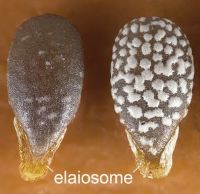 (basalbasal:
(basalbasal:
at or pertaining to the point of attachment; (of embryo) embryo occupies one end of the seed
) or carunclescaruncle:
a localized outgrowth of the seed coat near the hilum of the seed; it functions as an elaiosome (apicalapical:
(apicalapical:
at or pertaining to the end of the seed or fruit distal from its point of attachment (i.e., base)
) present in some genera, if present, white, smooth, or wrinkledwrinkled:
surface relief—shallow, irregular folds and furrows covering the surface; appearing overall though crumpled and then spread out .
.
Seed coat free of the pericarppericarp:
fruit wall or fruit coat
. Seed coat traits may be helpful in identification within some tribes. More information is needed to include a comprehensive summary here.
Embryo well developed, completely to nearly completely filling seed coat, axileaxile:
on or of the axis
and centric, foliatefoliate:
appearing leaf-like
, straight. Cotyledons spatulatespatulate:
2D shape—like a spatula; rounded at the apex, with base long and tapered; (of embryo) embryo is straight and axile and centric with the cotyledons expanded to form the shape of a spatula or spoon; (of cotyledons) cotyledons expanded and wider than the stalk but not invested into the stalk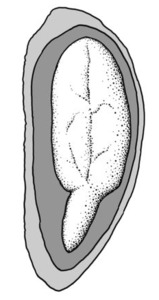 .
.
Endosperm scanty, smooth, oily.
Noxious Weeds: USA Federal Noxious Weed List, terrestrial, Ageratina adenophora (Sprengel) King & Robinson; Ageratina riparia (Regel) R.M. King and H. Robinson; Arctotheca calendula (Linnaeus) Levyns; Carthamus oxyacantha M. Bieberstein; Crupina vulgaris Cassini; Mikania cordata (Burman f.) B. L. Robinson; Mikania micrantha Kunth; Onopordum acaulon Linnaeus; Onopordum illyricum Linnaeus; Pentanema britannicum (L.) D. Gut. Larr. et al. (=*Inula britannica L.); Senecio inaequidens DC.; Senecio madagascariensis Poir.; Tridax procumbens L.
*Name listed in USA Federal Noxious Weed Regulations and tool linked below.
Federal Noxious Weed Disseminules of the US tool provides keys, descriptions, and images of these species. Aquarium & Pond Plants of the World tool includes description and images of aquatic plants in this family that may be encountered, especially those that are cultivated and/or weedy.
| Fruit | |
| Type | cypselacypsela: dry, indehiscent, unilocular fruit with a single seed not adnate to the pericarp, similar to an achene but developed from an inferior ovary. Fruit type of Asteraceae.  , drupedrupe: , drupedrupe:(indehiscent drupe) a fleshy, indehiscent fruit with one more hard pits enclosing seeds, derived from single, superior, simple or compound ovary; (dehiscent drupe) a fruit with a dry or fibrous to fleshy or leathery outer husk that early to tardily breaks apart (or opens), exposing one or more nutlike pits enclosing the seeds 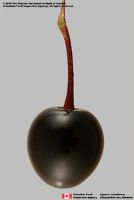 |
| Size range | usually 2–5 mm long, range 0.2–70 mm long |
| Shape(s) | globoseglobose: 3D shape—more or less spherical  , gibbousgibbous: , gibbousgibbous:swollen on one side 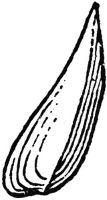 , lens-shapedlens-shaped: , lens-shapedlens-shaped:2D shape—round and flattened with two curved (convex) surfaces , ellipsoidellipsoid: 3D shape—elliptic , linearlinear: (shape) long, narrow, and uniform in width; (of embryo) embryo is straight and much longer than wide  , fusiformfusiform: , fusiformfusiform:spindle-shaped; broadest at the middle and tapering at both ends 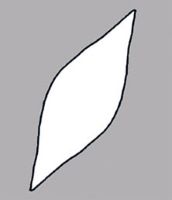 , falcatefalcate: , falcatefalcate:shaped like a scythe or sickle  , ovoidovoid: , ovoidovoid:3D shape—ovate  , lanceoloidlanceoloid: , lanceoloidlanceoloid:3D shape—lanceolate , urceoloid, conicalconical: 3D shape—cone-shaped, with the point of attachment at the broad end 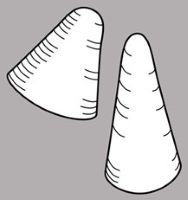 , cylindricalcylindrical: , cylindricalcylindrical:3D shape—a cylinder, with parallel sides and a circular cross-section; tubular or rod-shaped , pear-shaped, cordiformcordiform: 3D shape—heart-shaped , flask-shapedflask-shaped: 3D shape—generally circular in cross-section, broadest at or below the middle, approximately globose below that and constricted above to a relatively narrow neck , wedge-shapedwedge-shaped: 2D shape—triangular and tapering to a point at the base 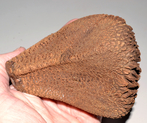 , 3- or 4-angled, sometimes curvedcurved: , 3- or 4-angled, sometimes curvedcurved:(of embryo) linear embryo is curved into an arch or horseshoe with the ends far apart  , contorted, or coiledcoiled: , contorted, or coiledcoiled:(of embryo) linear embryo is very long and bent to form a coil whereby one end of the embryo is on the outside and the other end near the middle of the seed  |
| Surface relief | smooth, ribbedribbed: surface relief—wide, prominent, linear ridges that are generally rounded and longitudinally situated on the surface  (3–40 ribs), ridgedridged: (3–40 ribs), ridgedridged:surface relief—raised, thick ridges, sharp edged or rounded, usually in a series that may cover the entire surface  , pittedpitted: , pittedpitted:surface relief—surface with small depressions in which the areas between the hollows do not take on the appearance of a true reticular net  , reticulatereticulate: , reticulatereticulate:surface relief—netted, raised walls or concave grooves forming a net-like surface pattern with flat, concave, or convex interspaces  , wartywarty: , wartywarty:surface relief—distinct, rounded projections that are large relative to the fruit size; tuberculate, verrucose  , wrinkledwrinkled: , wrinkledwrinkled:surface relief—shallow, irregular folds and furrows covering the surface; appearing overall though crumpled and then spread out  , papillosepapillate: , papillosepapillate:surface relief—bearing minute, distinct, broad-based projections, tapering to a rounded apex  , spiculiferous, muricatemuricate: , spiculiferous, muricatemuricate:surface relief—rough with small, hard, sharp projections , scalyscaly: surface relief—covered with small, thin, fine scales or flakes that may be removable  , veinedveined: , veinedveined:surface relief—lines that intersect in a vein pattern that is flush or slightly raised from the surface  , rarely groovedgrooved: , rarely groovedgrooved:surface relief—linear depressions that may be single or form a series of grooves over the surface  , or with hookswith hooks: , or with hookswith hooks:bristles or spines with curved or backwards pointing tips, or with secondary bristles along their length  , bristles, spines, myxogenicmyxogenic: , bristles, spines, myxogenicmyxogenic:mucilaginous when wetted cells, resin sacs or canals, gland-dotted |
| Color(s) | usually black or brown, sometimes pale blue, green, gray, red, yellow, white, streaked or mottledmottled: with colored spots, streaks, or blotches of a different color  , rarely blue-black , rarely blue-black |
| Unique features | Usually small, black or brown, hardened cypselaecypsela: dry, indehiscent, unilocular fruit with a single seed not adnate to the pericarp, similar to an achene but developed from an inferior ovary. Fruit type of Asteraceae.  . Fruits often topped with a cluster of bristles, scales or awnsawn: . Fruits often topped with a cluster of bristles, scales or awnsawn:a narrow, bristle-like organ, as on the glumes or lemmas of grasses  (which may be lost during handling) and stylestyle: (which may be lost during handling) and stylestyle:in a flower, the narrow and elongated part of the pistil between the stigma and the ovary; sometimes persisting in fruit  or stylar scar centered and conspicuous within the cluster. Abscission scars conspicuous at one end and opposite persistent stylesstyle: or stylar scar centered and conspicuous within the cluster. Abscission scars conspicuous at one end and opposite persistent stylesstyle:in a flower, the narrow and elongated part of the pistil between the stigma and the ovary; sometimes persisting in fruit  or stylar scars. Seeds usually held within cypselaecypsela: or stylar scars. Seeds usually held within cypselaecypsela:dry, indehiscent, unilocular fruit with a single seed not adnate to the pericarp, similar to an achene but developed from an inferior ovary. Fruit type of Asteraceae.  and completely or nearly completely filledfilled: and completely or nearly completely filledfilled:(of embryo) embryo fills the seed interior with the food reserves stored in the cotyledons; small amounts of endosperm may remain around the embryo 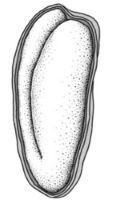 with a straight embryo. with a straight embryo. |
| Other | |
| Embryo | well developed, completely to nearly completely filling seed coat, axileaxile: on or of the axis and centric, foliatefoliate: appearing leaf-like , straight. Cotyledons spatulatespatulate: 2D shape—like a spatula; rounded at the apex, with base long and tapered; (of embryo) embryo is straight and axile and centric with the cotyledons expanded to form the shape of a spatula or spoon; (of cotyledons) cotyledons expanded and wider than the stalk but not invested into the stalk  . . |
| Nutritive tissue | endosperm present, scanty, smooth, oily |
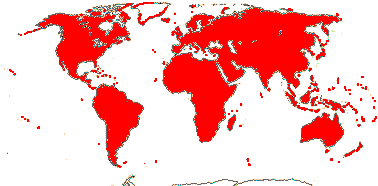
Distribution map courtesy of Angiosperm Phylogeny Website.
Flora of North America Editorial Committee 1993+Flora of North America Editorial Committee 1993+:
Flora of North America Editorial Committee, eds. 1993+. Flora of North America North of Mexico [Online]. 22+ vols. Flora of North America Association, New York and Oxford. Accessed January-March 2024. URL: http://beta.floranorthamerica.org.; Frangiote-Pallone and de Souza 2014Frangiote-Pallone and de Souza 2014:
Frangiote-Pallone S. and de Souza LA. 2014. Pappus and cypsela ontogeny in Asteraceae: structural considerations of the tribal category. Revista Mexicana de Biodiversidad 85: 62-77. DOI: 10.7550/rmb.32809; Kirkbride et al. 2006Kirkbride et al. 2006:
Kirkbride JH, Jr, Gunn CR, and Dallwitz MJ. 2006. Family guide for fruits and seeds, vers. 1.0. Accessed September 2020-January 2022. URL: https://nt.ars-grin.gov/seedsfruits/keys/frsdfam/index.cfm .; Koekemoer et al. 2023Koekemoer et al. 2023:
Koekemoer M, Steyn HM, and Bester SP. 2023. Guide to plant families of southern Africa Lucid Key. South African National Biodiversity Institute. Accessed March 2023.; Kubitzki et al. 1990+Kubitzki et al. 1990+:
Kubitzki K et al., eds. 1990+. The families and genera of vascular plants. 7+ vols. Berlin etc.; Lionakis Meyer 2017Lionakis Meyer 2017:
Lionakis Meyer DJ. 2017. Identification Guide for Some Common and Noxious Thistle and Knapweed Fruits (Asteraceae, tribe Cardueae). California Department of Food and Agriculture, 13 pp.; Marzinek et al. 2008Marzinek et al. 2008:
Marzinek J, Cavalari de-Paula O, and Trombert Oliveira DM. 2008. Cypsela or achene? Refining terminology by considering anatomical and historical factors. Revista Brasil. Bot. 31(3): 549&-553.; Noxious Weed Regulations 2020Noxious Weed Regulations 2020:
Noxious Weed Regulations. 2020. 7 C.F.R. sect; 360.100-360.600.; Takhtajan 2009Takhtajan 2009:
Takhtajan A. 2009. Flowering plants: Second edition. Springer Nature, Switzerland. 871 pp.; USDA 1980USDA 1980:
United States Dept. of Agriculture (USDA). 1980. Major weed family identification guide. Hyattsville Md, United States ; Zhengyi et al. 2004+Zhengyi et al. 2004+:
Zhengyi W, Raven PH, and Deyuan H. 2004+. Flora of China [online]. 25 vols. Science Press, Beijing China & Missouri Botanical Garden, St. Louis USA. Accessed January–March 2024. http://flora.huh.harvard.edu/china/
*The number of genera and species is based on Christenhusz and Byng 2016Christenhusz and Byng 2016:
Christenhusz MJM and Byng JW. 2016. The number of known plant species in the world and its annual increase. Phytotaxa 261 (3): 201-217. https://doi.org/10.11646/phytotaxa.261.3.1, which may differ from the number of genera in GRIN-Global.